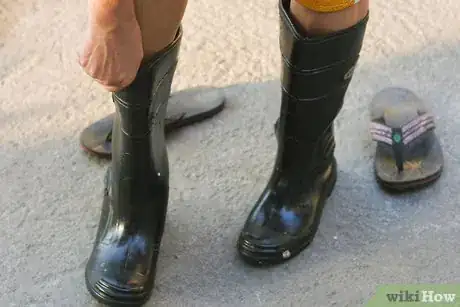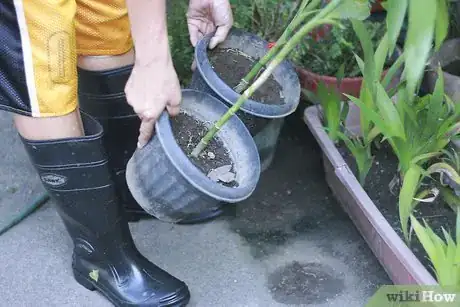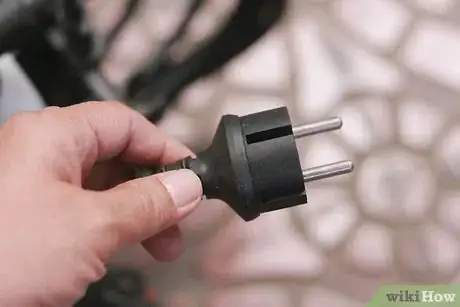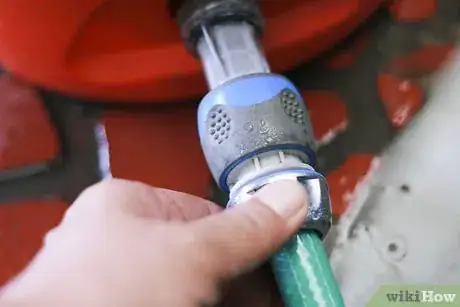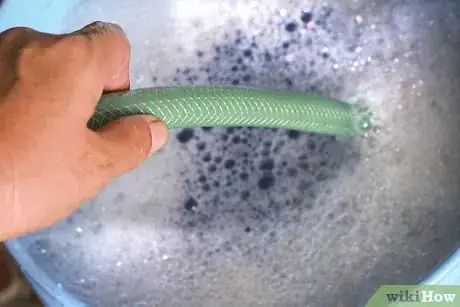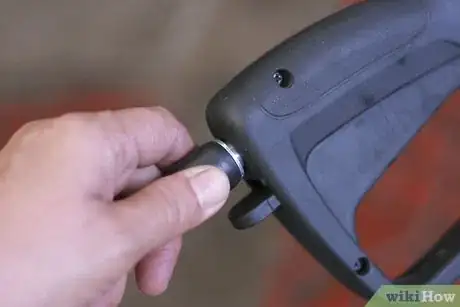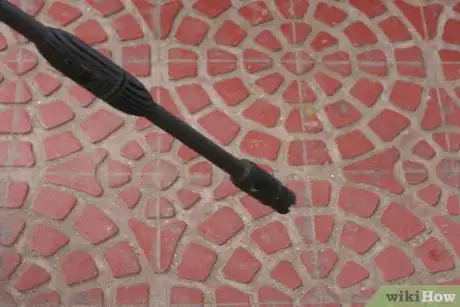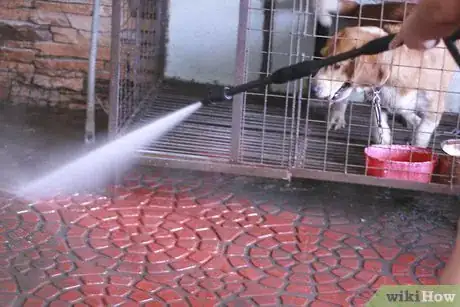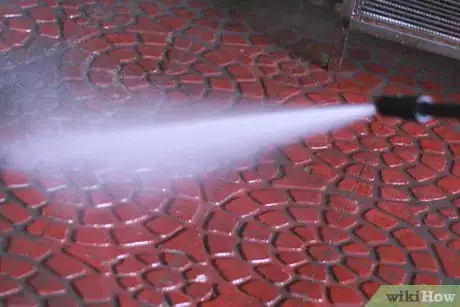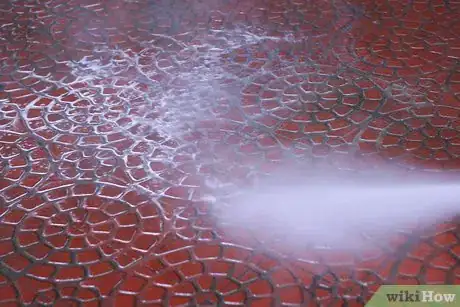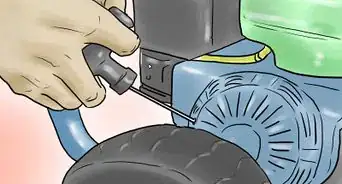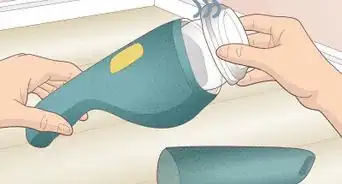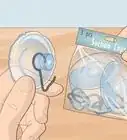This article was co-authored by wikiHow Staff. Our trained team of editors and researchers validate articles for accuracy and comprehensiveness. wikiHow's Content Management Team carefully monitors the work from our editorial staff to ensure that each article is backed by trusted research and meets our high quality standards.
This article has been viewed 142,174 times.
Learn more...
A power washer has considerably more cleaning power than what you can get with a garden hose; however, that power also has an inherent danger of injury or damage to property. You want to make sure you know how to use a power washer before you turn it on.
Steps
Preparing to Use a Power Washer
-
1Wear appropriate safety attire. You should have safety goggles and protective footwear on. The footwear should also have a rubberized sole to minimize the risk of slipping on wet surfaces. You may want to wear long pants and a long-sleeved shirt to protect your limbs from flying dirt and debris.[1]
-
2Protect plants and breakable objects by moving them out of the way or covering them.[2]Advertisement
-
3Get the power washer ready for use.
- Fill a gas power washer with engine oil and gasoline. Hold the start grip and pull to start the engine.
- Plug an electric power washer into a properly grounded outlet.
-
4Connect a garden hose to the pressure washer water inlet. Turn on the water supply before turning on the pressure washer to avoid damaging the pump.[3]
-
5Fill the reservoir or a bucket (on a siphon system) with a detergent solution if you want extra cleaning power.
-
6Attach the proper spray tip to the nozzle.[4] Certain tips may be required when using detergent. Make sure you read the manufacturer's instructions carefully.
Operating a Power Washer
-
1Position the spray tip at least 2 feet (0.61 m) (0.6 m) from the surface to start. Gradually move the tip closer. You risk damaging the surface if you hold the tip closer than 12 inches (30.5 cm) (0.3 m).
-
2Hold the nozzle at a 45-degree angle to the surface. These will help direct loosened debris away from you. Pull the trigger to begin spraying the water.[5]
-
3Move the spray in a side-to-side motion, without spraying too long in any one spot.
-
4Apply detergent by starting low and moving upwards. Allow the detergent to soak for at least 3 minutes before rinsing. Don't wait long enough for it to dry. Rinse the surface by spraying water from the top down.
-
5Follow the manufacturer's instructions for flushing the system after using detergent in a power washer.
Community Q&A
-
QuestionHow do I start if there is too much pressure?
 Community AnswerSqueeze the trigger on the hand wand. This will relieve the pressure. If it builds back up before you get it started, squeeze it again. Sometimes I squeeze the trigger with my left hand while I pull the start cord with my right hand.
Community AnswerSqueeze the trigger on the hand wand. This will relieve the pressure. If it builds back up before you get it started, squeeze it again. Sometimes I squeeze the trigger with my left hand while I pull the start cord with my right hand. -
QuestionWhen using the washer does it hurt the pump if I leave it running without depressing the trigger?
 Community AnswerFor a minute or two, no. It's designed to recirculate the pumped water back into the inlet when the unloader activates (which is what happens when you release the trigger). Keep in mind though, if you allow it to keep running, the recirculated water gets hot from the friction. This can cause problems in the pump, or the temperature-sensitive relief valve will dump the hot water. In either case, the pressure washer would be temporarily out of service until the pump was repaired, or the relief valve was reset.
Community AnswerFor a minute or two, no. It's designed to recirculate the pumped water back into the inlet when the unloader activates (which is what happens when you release the trigger). Keep in mind though, if you allow it to keep running, the recirculated water gets hot from the friction. This can cause problems in the pump, or the temperature-sensitive relief valve will dump the hot water. In either case, the pressure washer would be temporarily out of service until the pump was repaired, or the relief valve was reset. -
QuestionHow long can you continuously run an electric power washer? Does it overheat if used more than an hour?
 Community AnswerElectric power washers can run for as long as you would like. It's the gas engine power washers that you will have to worry about. Some people will say that the water keeps the engine cool. Completely incorrect. The water has nothing to do with the engine. Furthermore, electric engines can be run for quite a while.
Community AnswerElectric power washers can run for as long as you would like. It's the gas engine power washers that you will have to worry about. Some people will say that the water keeps the engine cool. Completely incorrect. The water has nothing to do with the engine. Furthermore, electric engines can be run for quite a while.
Warnings
- Keep the connection between the power cord on an electric power washer and an extension cord out of standing water to avoid the chance of an electric shock.⧼thumbs_response⧽
- Never aim the spray from a power washer at any part of your body, someone else, or animals.⧼thumbs_response⧽
- Never use a pressure washer while standing on a ladder. Instead, use a power washer with an extension wand.⧼thumbs_response⧽
- Keep power washers out of reach of children. They could cause serious damage to themselves, someone else or property if they mistakenly assume it's just a big squirt gun.⧼thumbs_response⧽
- Don't operate a gas power washer in an enclosed area. The exhaust fumes could lead to carbon monoxide poisoning.⧼thumbs_response⧽
- If cleaning siding with a power washer, keep the spray at a downward angle to avoid forcing water up behind the siding.⧼thumbs_response⧽
References
- ↑ https://cleanup.expert/info/pressure-washers-beginners-guide/
- ↑ https://cleanup.expert/info/pressure-washers-beginners-guide/
- ↑ https://www.homedepot.com/c/ah/how-to-use-a-pressure-washer/9ba683603be9fa5395fab901a104888
- ↑ https://www.homedepot.com/c/ah/how-to-use-a-pressure-washer/9ba683603be9fa5395fab901a104888
- ↑ https://www.familyhandyman.com/tools/how-to-use-a-pressure-washer/
- http://www.hometips.com/diy-how-to/house-siding-power-pressure-wash.html
- http://bsintek.basco.com/BriggsDocumentDisplay/default.aspx?filename=gfhtyHXAnfBhU7y
About This Article
Before you use a power washer, put on protective clothing, including goggles, long-sleeved clothing, boots, work gloves, and non-slip shoes. If your power washer is gas powered, make sure to wear ear protection as well. Then, fill it up with fuel. Alternatively, connect it to a grounded power source if it’s an electric model. Next, connect your garden hose to the washer and a spray tip to the nozzle. Position the tip at least 2 feet away from the surface you want to clean. Point the nozzle at a 45 degree angle to the surface, which will help direct flying debris away from you. Once you’re in position, pull the trigger to spray the water. Spray from side to side, taking care not to stay on one spot for too long. For tips on how to use detergent in a pressure washer, keep reading!
